Toshiba Chromebook 2: A Feast for the Eyes
by Jarred Walton on February 11, 2015 10:00 AM ESTToshiba Chromebook 2: A Beautiful Display
We’ve talked quite a bit already about the great display in the Toshiba Chromebook 2. Really, it’s the primary reason to buy this laptop over one of the alternatives, and as such it’s the best place to start our objective benchmarks. For these tests, we can’t create a color profile so what you get in the box is what you’re going to have to live with, meaning display quality becomes even a bit more important. On the other hand, it’s also important to remember that having really accurate colors is mostly a concern for imaging/video professionals or A/V enthusiasts, and you could certainly argue that neither group is really looking to use a Chromebook. For most users, the most compelling aspect is going to be the LCD viewing angles, as it means you don’t have to be positioned perfectly to get a legible screen:
TN panels always have problems with vertical viewing angles, which makes them a particularly bad choice on laptops as you’re frequently looking at the screen from slightly above rather than straight on. Over the years, at least that aspect has improved slightly, but it’s still clearly inferior to the experience that an IPS panel can offer – and don’t even get me started on the “from below” angles on TN, though that’s usually less of a concern. The Toshiba Chromebook 2 1080p display has no problems, regardless of viewing angle, and you reach the point where the angle is far too oblique to be useful before you have any issues with color shifting. Let’s move on to the color accuracy figures.
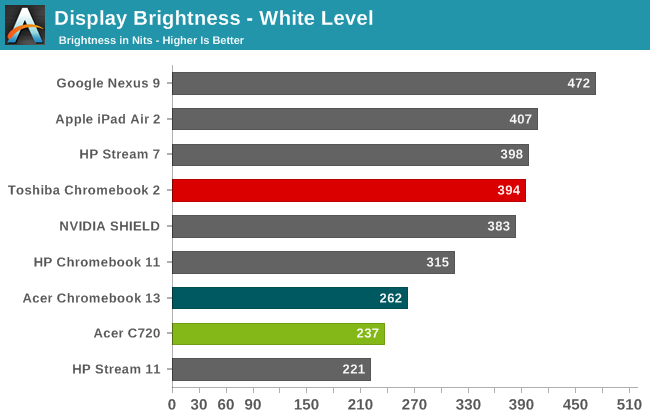
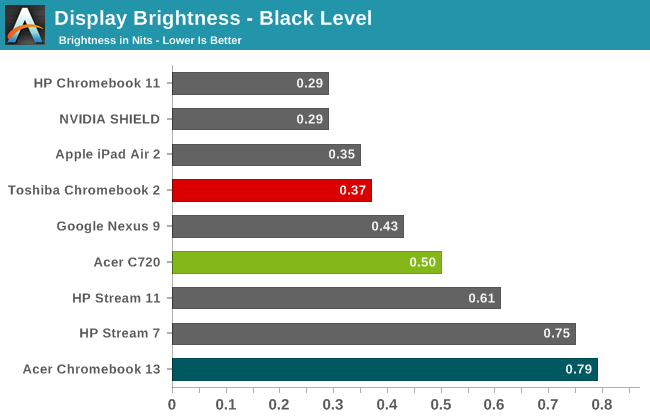
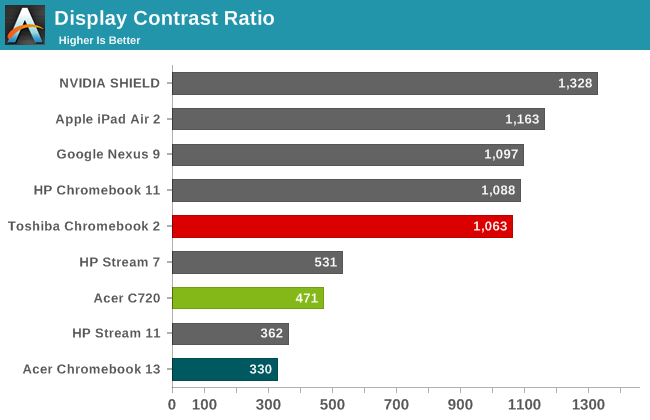
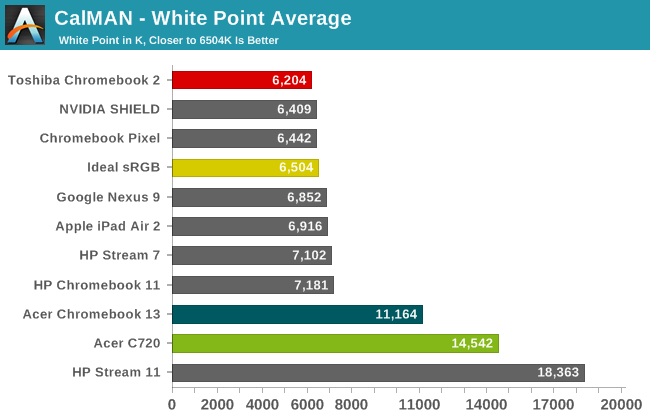
The maximum brightness of nearly 400 nits is great to see, as it makes this laptop useable even in outdoor environments, though reflections from the glossy display can still be a problem. The black levels at maximum brightness are 0.371 as well, which while not perfectly black are still closer than what you’ll see on most other laptops. Combined, we end up with a contrast ratio of 1063:1, though I should note that contrast improved at 200 nits to 1291:1 thanks to a proportionally better black level. The white point is also quite good, coming closer to the desired 6504K than any other Chromebook we’ve tested so far.
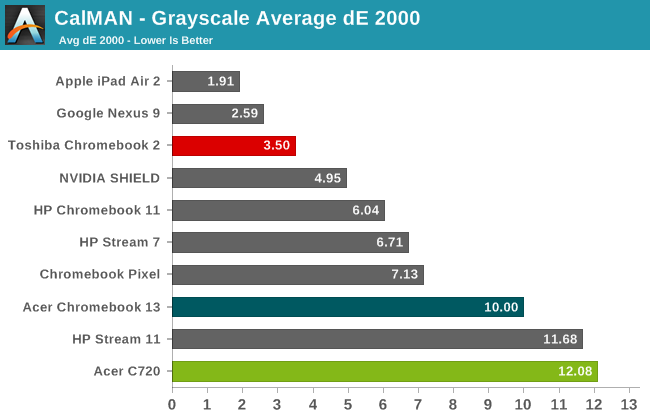

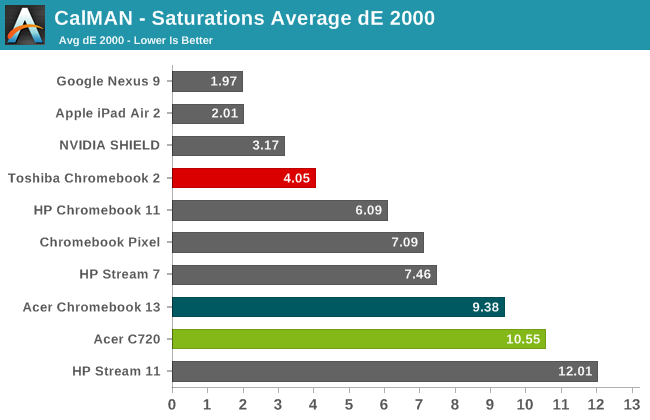
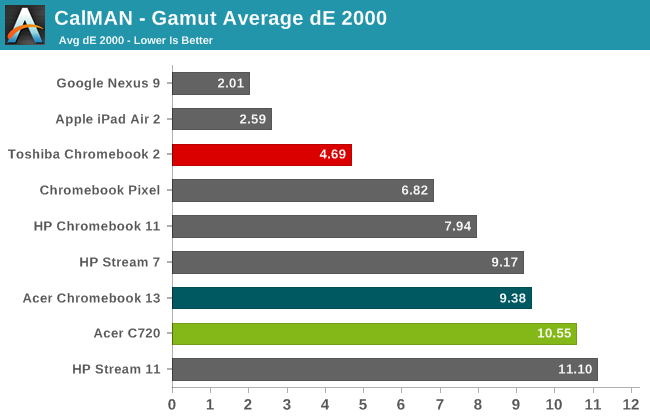
Delta E values could still be improved, but it has to be said that the Toshiba display still rates far better than the vast majority of Windows laptops we’ve tested. There are definitely colors that miss the mark, but in most of our tests the average Delta E ends up being around 4.0, which is higher than the desired average of 3.0 but quite a bit lower than the point where inaccuracies start to become distracting (6.0). The only displays we’ve tested in the above charts that do better overall are on the Nexus 9 and iPad Air tablets, and those are the two best tablet displays we’ve tested. When you look at the results of the other Chromebooks (including the Pixel), Toshiba really stands out from the crowd of mediocre color quality.
If you want more details on the display, the above gallery contains additional charts for our LCD quality testing. Color gamut is basically equal to sRGB, which is what most people would want on an Internet-centric device. Basically, it's a really good display, and exceptional to find such quality on a $300 laptop. I just wish we could get any Windows laptop for under $750 with something close to this level of quality. For all of those who comment that they “stopped reading after seeing how bad the display was”, at least this time there’s nothing to complain about. I still wish this sort of performance was more of the norm rather than the exception, and perhaps we’ll get there over the coming years, but regardless it’s a nice change of pace – and all the more refreshing to see on a $329 device.





















66 Comments
View All Comments
ezschemi - Wednesday, February 11, 2015 - link
Table on page 1 says:"Intel Celeron N2840
Dual-core 2.16-2.58GHz"
while directly below the text says:
"The processor of choice this time is Intel’s Celeron N2840, a quad-core Bay Trail chip running at 2.16-2.58GHz."
dual core vs quad core. One of them is incorrect.
JarredWalton - Wednesday, February 11, 2015 - link
Fixed. I initially thought it was a quad-core CPU (before doing additional checking), and apparently I wrote that part of the text before I fixed the table. I think I actually had the CPU listed as the N2940 at one point, which is the quad-core part.BrokenCrayons - Wednesday, February 11, 2015 - link
It's nice hardware for Chrome OS, but what worries me is that there are two fundamental problems. The price for what ought to be a budget-friendly, inexpensive throw away device is far too high when compared to cheap Windows-based notebooks like the Stream 11 (which isn't favored in benchmarks in this article, but as those benchmarks are largely Google-based and Google products will invariably see favorable numbers due to bias). In fact, across the board, Microsoft devices have really turned the tables on pricing, seemingly winning the race to the bottom with sub-$100 dollar tablets and that ilk that have greater functionality than any Chrome OS or Android device. In a price- and feature-sensitive market, Google appears to have presently lost the lead.The other problem is fundamental to the Chrome OS design being cloud-centric using Google services. Google isn't a company that's no longer commonly trusted to be a proper caretaker for user data and I often wonder what kind of information about what I'd be doing on any Google product is being sent upstream to be stored for an indefinite time period and then monetized. The general sense I get is that these sorts of trust issues are already a problem (as Google's recent moves to take Glass development in-house and out of the public view where people are being punched in the face for wearing it) and are likely to get more prominent as information security takes a more prominent role that enhances public awareness. It's a perfect storm that's brewing and Google's business model places it at the very heart of the looming controversy.
SM123456 - Saturday, February 14, 2015 - link
The Stream 11 hardware is identical to most entry level Chromebooks using the Intel Celeron N2840 Dual core Atom Bay Trail CPU and 23GB eMMC storage which are also priced $199, but the Stream 11 runs the full browser benchmarks (Google Octane and Firefox Kraken) at half the speed of the identical Chromebooks and about a third of the speed of the $179 Acer C720 Haswell Celeron 2955U Chromebooks. This is nothing to do with the fact that the benchmarks are specified by Google or Firefox - they are both good indicators of overall performance - ie. rendering, video/audio decoding, SSL encryption/decryption, etc as well as Javascript code execution - unlike SunSpider for example which just benchmarks Javascript execution.This is entirely due to the Windows resource hog the system as everything else is identical. The Sunspider pure Javascript benchmarks aren't affected by the Windows resource hog because they don't need much resources, while the full browser function benchmarks are, because they do hog resources - eg. RAM disk swap of virtual memory, use of shared RAM for graphics etc.
AnnonymousCoward - Wednesday, February 11, 2015 - link
No mention of color gamut?16GB is pathetic storage for a laptop. 32GB microSD cards are sold for $14 shipped in retail. Toshiba was literally just trying to save a few bucks. As a consumer, wouldn't you rather pay $335 instead of $330 to have 32GB? I hate it when companies cut corners like this.
The marketing dept was clearly copying Apple with those pictures, adding the diagonal glare line.
JarredWalton - Wednesday, February 11, 2015 - link
Sorry -- I had the images and forgot to include them on the LCD page. I've added another gallery at the bottom of page 3.AnnonymousCoward - Thursday, February 12, 2015 - link
Thanks Jarred! That's commendable that you respond to and address our feedback :)CoreLogicCom - Wednesday, February 11, 2015 - link
It's not storage for the user (unless the user is specifically using Offline capable apps). It's local storage only for the OS. The user is supposed to be 100% network connected and be using the cloud (Google Drive), which itself is 100GB of space.bsd228 - Wednesday, February 11, 2015 - link
you have 2 usb ports and an SD card slot. If you want local storage, it's trivial to add, using one of those tiny form factor usb sticks.AnnonymousCoward - Thursday, February 12, 2015 - link
Ok, the SD slot sounds like a reasonable solution for a decent hard drive.